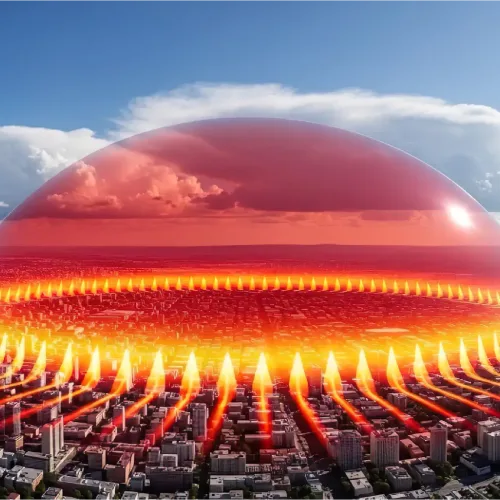Scientists have wondered from the very first exoplanet discovery: Can it support life? With thousands of worlds now confirmed beyond our solar system, they needed a clear and quick way to judge which ones might be habitable—at least for life as we know it. That’s why they created the Exoplanet Habitability Index. It doesn’t give a perfect answer, but it works as our first important tool to filter the endless universe in search of a true “New Earth.”
The Search for Earth 2.0: Exoplanet Habitability Explained
It is difficult to believe. Over the past decade, we have discovered thousands of planets other than our solar system. These exoplanets come in all shapes and sizes; some are gas giants like Jupiter, while others are rocky like Earth. But here is the thing: not every exoplanet is a suitable candidate for life. Some are too hot. Some are too cold. A few planets lack an atmosphere, leaving life exposed to dangerous radiation. Without protection, harmful rays can reach the surface, making survival difficult. That’s where the Exoplanet Habitability Index comes in. It helps researchers figure out which planets actually have the right conditions to support life.
What Is the Exoplanet Habitability Index?
Simply put, the Exoplanet Habitability Index is like a rating system for planets. It gives scientists a way to rank how similar a planet is to Earth based on certain criteria. These criteria include the planet’s distance from its star. Another important aspect is the availability of liquid water. This factor plays an essential role in many processes. It also considers whether the planet has an atmosphere. The closer a planet’s score is to 1, the more Earth-like it is. This tool is very useful. Every year, scientists discover many new exoplanets. As a result, this tool becomes even more valuable. It helps us better understand these exciting discoveries.
How Does the Habitability Index Work?
So, how do scientists find out whether a planet can support life? The habitability index looks at several essential factors. First is the habitable zone. This is also known as the “Goldilocks zone.” In this zone, temperatures are just right for liquid water to exist. Their temperature is just right, not too hot and not too cold. Planets within this zone have a better chance of supporting life because water is a basic ingredient.
Let’s break it down further in this quick table:
| Factor | Why It is Important |
|---|---|
| Distance from the Star | Affects temperature |
| Liquid Water | Essential for life |
| Atmosphere | Provides protection and gases |
| Surface Temperature | Affects climate conditions |
If a planet scores well in these areas, scientists give it a high habitability score. The higher the score, the more Earth-like the planet will be.
The Earth Similarity Index (ESI): The Foundation
The ESI is the most popular tool scientists use to judge how habitable a world might be. It works by giving a simple number that shows how closely an exoplanet matches the Earth. The ESI doesn’t predict whether life exists there. It only tells us how similar the planet’s conditions are to those on Earth.
The ESI Scale: What Do the Numbers Mean?
The Earth Similarity Index is represented by a value between 0 and 1.
- ESI = 1.0: This score is reserved for Earth itself. No other planet has ever reached this value.
- ESI > 0.8: These are considered the most Earth-like planets. They have high potential for being rocky and maintaining liquid water.
- ESI between 0.6 and 0.8: These are often called “optimistically habitable.” They sit in the star’s habitable zone. The conditions may be slightly too hot, slightly too cold, or have high gravity.
- ESI < 0.6: These planets are generally considered non-habitable or gas giants.
The Four Core Factors of ESI Calculation
To work out the Earth Similarity Index (ESI), scientists bring together four main factors using a geometric mean. These physical traits let us compare other planets directly with Earth:
- Radius (Size): A planet’s size shows whether it is rocky like Earth or a gas giant like Jupiter.
- Density (Composition): The way a planet’s mass is packed reveals its structure and what it’s made of.
- Escape Velocity: This is the speed an object needs to break free from the planet’s gravity. It tells us if the planet can hold onto a thick, life-supporting atmosphere.
- Surface Temperature: Perhaps the most critical factor, since it shows whether liquid water could exist on the planet’s surface.
Real-World Examples: ESI in Action
When we compare the ESI of confirmed worlds, it quickly becomes clear why this index works as such a powerful tool for filtering.
| Celestial Body | ESI Value (Similarity to Earth) | Classification | Key Takeaway |
|---|---|---|---|
| Earth | 1.00 | The Baseline | The only world confirmed to host life. |
| Kepler-452b | 0.83 | Super-Earth | One of the highest ESI scores; often called Earth’s “older cousin.” |
| Mars | 0.73 | Solar System Comparison | While inside the Sun’s habitable zone, its low ESI reflects its thin atmosphere and lack of surface water. |
| Gliese 667 Cc | 0.80 | Optimistically Habitable | The first super-Earth found in a star’s habitable zone. |
Critical Factors in the Exoplanet Habitability Index
1. Water
Water is life. It is very essential for every living thing on Earth. When we search for life, we start by assessing the possibility of liquid water presence in the setup. In fact, if there is water on a planet, it instantly scores high on the habitability scale. Why? This is because water participates in chemical reactions. These are elementary reactions essential for life as we know it.
2. Atmosphere
People studied atmospheres as a part of outer space. Each atmosphere differs in the way it acts as a shield for the planet. It protects life from unwanted things, as well as regulating the temperature. Firstly, without a proper climate, it would be really difficult to survive on our planet. A thick cover like the Earth’s atmosphere helps to sustain life, so it ranks such planets higher.
3. Temperature
Another important thing is the temperature. It is common to go to a shopping center in cold weather. Yet, inside it is very hot, mainly because of the light. If a planet is too hot, water evaporates, that is, it boils and turns into steam. Three simple operating rules of nature come to mind. One rule is that if it is too cold, water will freeze. The Earth is located exactly where it should be, where the temperature allows water to stay in its liquid form. The habitability index measures the extent to which a planet matches these conditions.
Recent Discoveries of Potentially Habitable Exoplanets
Missions like Kepler and TESS have found some very exciting candidates. One of the top contenders is Proxima Centauri b, a planet orbiting our closest neighboring star. It is in the habitable zone and has a habitability score of an impressive 0.87. Another exciting discovery is Kepler-452b, often referred to as “Earth’s cousin.” This planet is slightly larger than Earth. It is located in the habitable zone of a star closest to our sun.
The Cosmos is within us. We are made of star stuff. We are a way for the universe to know itself—Carl Sagan
What’s Still Holding Us Back?
Even though we have made a lot of progress, finding a planet like Earth is still difficult. Most exoplanets are light years away, so it is hard to study them in detail. We can not just send a spacecraft to take a closer look, at least not yet. For now, we rely on data from telescopes and space missions to estimate a planet’s habitability. But the margin of error is huge. Some planets that look promising may not actually be habitable for one reason or another.
The Future of Space Exploration

Fortunately, this work always has a future. Scientists expect future observations to give more refined pictures of exoplanets. These include insights into their atmospheres as the James Webb Space Telescope (JWST) begins operating. Also, analyzing highly-rated planets for habitability will help scientists. They aim to find the most suitable candidates from existing worlds. And who knows? In the next decade, we find a planet that really looks like we live here.
Hope for a Second Earth
The idea of finding another Earth is now more than just a fantasy. Due to the Exoplanet Habitability Index, we have a plan of action to guide us. While the search is far from over, we are getting closer to it every day. As new discoveries keep coming to light, it’s exciting. We one day set foot on a planet that isn’t too different from our own.
Beyond Similarity: Limitations and the Future
The Earth Similarity Index (ESI) works as a useful first step. However, it has clear limits. Astronomers are still trying to overcome these limits. ESI only measures how similar a planet is to Earth, it doesn’t reveal whether life is actually there.
For example, the ESI doesn’t consider a planet’s atmosphere. A planet might have the right temperature, but if its air is full of toxic gases, life can’t survive. It also ignores the presence of a magnetic field. This field plays a vital role in shielding a planet’s surface from dangerous radiation.
Because of these gaps, scientists created a more advanced tool: the Exoplanet Habitability Index (EHI). Unlike ESI, the PHI looks deeper. It checks for things like liquid solvents. It also looks for sources of energy and chemical complexity. These are factors that point more directly to the possibility of life.
Still, the ESI remains the most widely recognized first filter in the cosmic hunt for worlds that could one day feel like home.
Recommended Reads for Curious Minds
Explore the search for new worlds with these fascinating reads, perfect for anyone curious about astrobiology.
- The Exoplanet Handbook by Michael Perryman
- The Planet Factory: Exoplanets and the Search for a Second Earth by Elizabeth Tasker
- Search for Life on Mars: The Greatest Scientific Detective Story of All Time by Nicholas Booth
- Alone in the Universe: Why Our Planet Is Unique by John Gribbin
Frequently Asked Questions About Exoplanet Habitability Index
No. A high score means potential habitability, but life requires conditions beyond physics, including chemistry and time.
Not directly, but their moons could be, especially if they have liquid oceans beneath ice layers.
Because other factors (like atmosphere or radiation) make them hostile despite location.
References
- Schulze-Makuch, D., Méndez, A., Fairén, A. G., et al. (2011). A Two-Tiered Approach to Assessing the Habitability of Exoplanets. Astrobiology, 11(10), 1041–1052.
- NASA Exoplanet Exploration Program – https://exoplanets.nasa.gov
- Méndez, A. et al. (2020). Planetary Habitability Index Database. University of Puerto Rico, Arecibo.
- Tarter, J. (2001). The Search for Extraterrestrial Intelligence (SETI). Annual Review of Astronomy and Astrophysics, 39, 511–548.
- Kasting, J. F., Whitmire, D. P., & Reynolds, R. T. (1993). Habitable Zones around Main Sequence Stars. Icarus, 101(1), 108–128.
- Schulze-Makuch, D., et al. (2011). “A two-tiered approach to assessing the habitability of exoplanets.” Astrobiology, 11(10): 1041-1052. (Defines the ESI and PHI concepts).
- Planetary Habitability Laboratory (PHL) at the University of Puerto Rico at Arecibo. (Provides updated ESI and habitability data).
- Kopparapu, R. K., et al. (2013). “Habitable zones around main-sequence stars: new estimates.” The Astrophysical Journal, 767(1): L8. (Defines the classic Habitable Zone boundaries).




